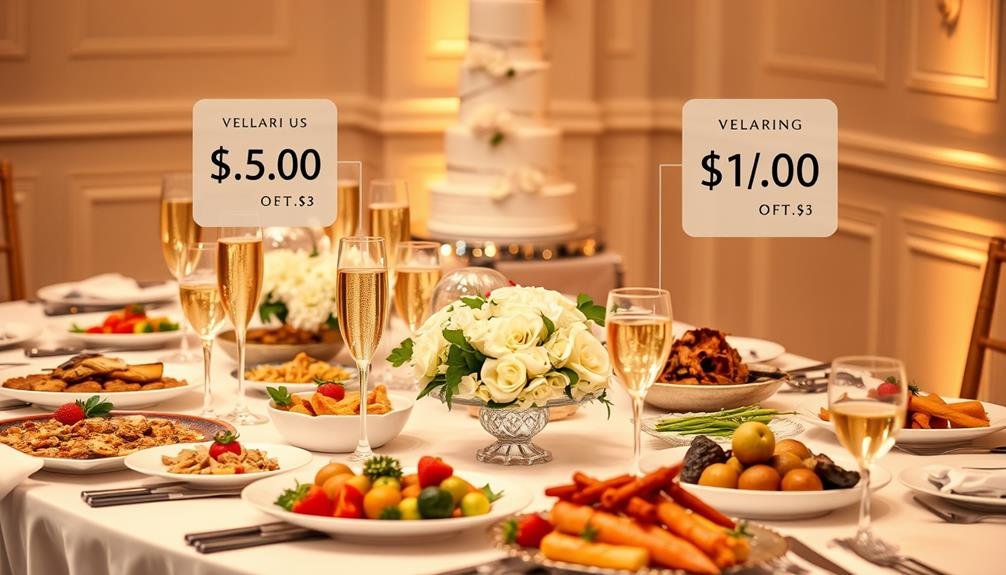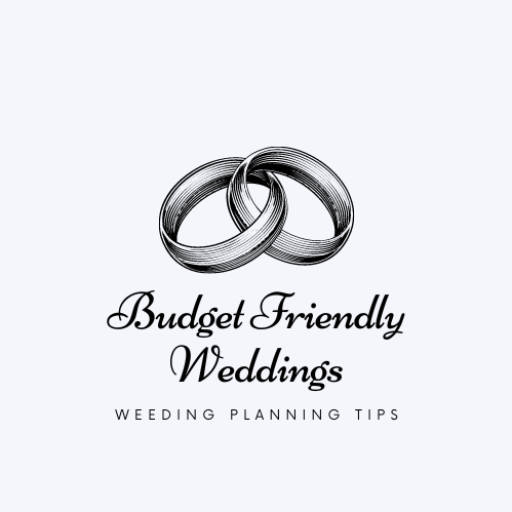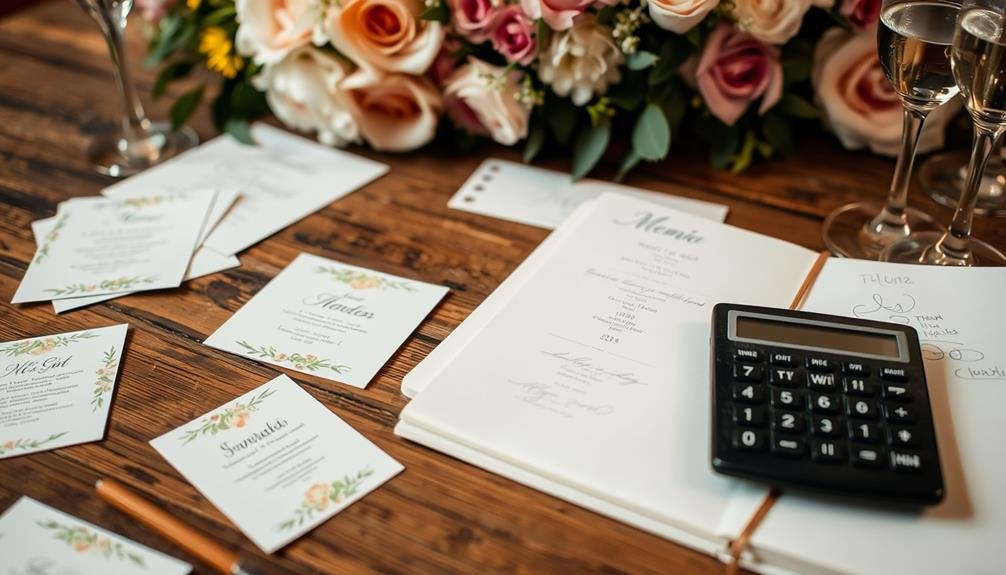When planning your wedding, you'll find that food and beverages typically consume 30-40% of your total budget. For a 100-guest wedding, expect to spend $6,000 to $12,000 on catering, with per-person costs ranging from $60 to $120. Your choices in meal service style, appetizers, main courses, desserts, and beverage packages will considerably impact your bottom line. Don't forget to factor in additional costs like staffing (15-20%), rentals (10-15%), and gratuity (15-20%). By understanding these elements and exploring money-saving tips, you'll be better equipped to create a memorable culinary experience without breaking the bank. Hungry for more details? There's a feast of information ahead.
Key Takeaways
- Catering expenses typically account for 30-40% of the total wedding budget, ranging from $6,000 to $12,000 for 100 guests.
- Per-person catering costs range from $60 to $120, including appetizers, main course, dessert, and non-alcoholic beverages.
- Meal service styles affect costs: plated dinners ($50-$150/person) are pricier than buffet-style ($30-$100/person) due to staffing differences.
- Dessert costs vary, with traditional wedding cakes ranging from $3 to $12 per slice and alternative options averaging $5-$15 per guest.
- Beverage packages range from $15-$25 per person for beer and wine, to $35-$50 per person for a full open bar.
Understanding Average Catering Costs

Understanding average catering costs is essential when planning your wedding budget. Typically, catering expenses account for 30-40% of your total wedding budget. For a 100-guest wedding, you can expect to spend between $6,000 and $12,000 on food and beverages.
The per-person cost for wedding catering usually ranges from $60 to $120. This includes appetizers, main course, dessert, and non-alcoholic beverages. Factors influencing this cost include menu selection, service style, and your location. Plated dinners tend to be more expensive than buffet-style meals.
You'll need to take into account additional costs such as staffing, rentals, and gratuity. Staffing usually accounts for 15-20% of the catering bill, while rentals (plates, utensils, glassware) can add another 10-15%.
Don't forget to factor in a 15-20% gratuity for the catering team.
Bar service is often a separate cost. You can expect to pay $15-$30 per person for beer and wine, or $35-$50 per person for a full open bar. Some venues allow you to provide your own alcohol, which can considerably reduce costs.
Meal Service Styles Compared
When planning your wedding menu, you'll need to take into account different meal service styles and their associated costs.
Plated dinners typically cost more than buffets due to increased staffing needs, while family-style dining offers a middle ground regarding price and guest interaction.
You'll want to weigh the pros and cons of each option, taking into account factors like your budget, venue space, and desired atmosphere for your special day.
Plated vs. Buffet Costs
For couples planning their wedding reception, choosing between plated meals and buffet-style service can greatly impact the food budget.
Plated meals typically cost more per person, ranging from $50 to $150, due to the higher staffing requirements and precise portion control. You'll need more servers to deliver each course, which increases labor costs. However, plated meals offer a more formal dining experience and can reduce food waste.
Buffet-style service often comes in at a lower price point, usually between $30 and $100 per person. This option requires fewer staff members, as guests serve themselves. Buffets also allow for more variety in food options and can accommodate larger guest counts more easily.
Keep in mind that you'll need to order more food to guarantee you don't run out, which can offset some of the savings.
When comparing costs, consider factors beyond just the per-person price. Factor in rental fees for serving equipment, linens, and additional décor for buffet tables.
Also, think about your guests' preferences and the overall atmosphere you want to create. Your venue's layout and kitchen capabilities may influence your decision as well.
Family-Style Dining Explained
Between plated meals and buffets lies a third option: family-style dining. This service style combines elements of both, offering a more interactive and communal dining experience. Large platters of food are brought to each table, allowing guests to serve themselves and pass dishes around, much like a family dinner at home.
You'll find that family-style dining can be more cost-effective than plated meals but potentially pricier than buffets. It requires fewer staff members than plated service but more than a buffet. You'll need to account for extra table space to accommodate the serving dishes, which may impact your table layout and decor plans.
Family-style dining encourages conversation and creates a relaxed atmosphere. It gives your guests more control over their portions while still providing a seated, structured meal.
However, it's important to take into account your menu carefully. Choose dishes that are easy to share and won't become messy or cold quickly. You'll also want to guarantee that guests with dietary restrictions can easily identify and access appropriate options.
Ultimately, family-style dining can be a great compromise if you're torn between the formality of plated service and the flexibility of a buffet.
Appetizer and Hors D'oeuvres Options

The allure of appetizers and hors d'oeuvres lies in their ability to set the tone for your wedding reception. These bite-sized delights not only tantalize your guests' taste buds but also keep them satisfied during the cocktail hour.
When planning your appetizer menu, consider a mix of hot and cold options to cater to different preferences.
Popular choices include:
- Mini crab cakes with remoulade sauce
- Caprese skewers with cherry tomatoes and fresh mozzarella
- Bacon-wrapped dates stuffed with goat cheese
As you select your appetizers, keep in mind dietary restrictions and allergies. Offer vegetarian, vegan, and gluten-free options to guarantee all guests can enjoy the spread. Aim for 3-5 pieces per person during a typical cocktail hour.
Your budget will play a significant role in determining the variety and quantity of appetizers. Passed hors d'oeuvres tend to be more expensive due to additional staffing costs, while stationary displays can be more cost-effective.
Consider a mix of both to create an engaging and memorable experience for your guests while keeping costs in check.
Main Course Considerations
After tantalizing your guests' palates with appetizers, it's time to turn your attention to the main course. This centerpiece of your wedding meal requires careful consideration to balance taste, dietary needs, and budget constraints.
Start by deciding on your service style: plated, buffet, or family-style. Plated meals offer elegance but can be more expensive due to increased staff requirements. Buffets provide variety and are often more cost-effective, while family-style creates a warm, communal atmosphere.
Next, choose your proteins. Chicken and fish are popular, budget-friendly options, while beef and lamb tend to be pricier. Consider offering a vegetarian option to accommodate dietary restrictions.
Factor in side dishes and vegetables to complement your mains.
Don't forget about presentation. Your caterer can elevate simple dishes with creative plating and garnishes. Seasonal ingredients can add flair while keeping costs down.
Dessert and Cake Expenses

When planning your wedding desserts, you'll need to evaluate various factors affecting the cake's cost, such as size, design complexity, and ingredients.
You might also want to explore alternative dessert options like cupcakes, pies, or a dessert bar to potentially save money or offer more variety.
As you budget for sweets, remember to calculate the per-guest pricing for desserts, which can help you make informed decisions about quantity and selection.
Wedding Cake Cost Factors
Budgeting for your wedding cake can be a sweet yet complex task. Several factors influence the final cost, and understanding these can help you make informed decisions. The size of your cake, which depends on your guest count, is a primary determinant. Larger cakes require more ingredients and labor, increasing the price.
The cake's design complexity also plays a significant role. Intricate decorations, hand-painted details, or elaborate fondant work will drive up the cost. Similarly, specialty flavors or fillings may be pricier than traditional options.
Don't forget to take into account the baker's skill level and reputation, as experienced professionals often command higher fees.
Here are some additional factors that affect wedding cake costs:
- Delivery and setup fees
- Custom cake toppers or decorative elements
- Rental of cake stands or display items
When planning your budget, remember that the average cost per slice can range from $4 to $8, depending on your location and specific requirements.
To save money, think about having a smaller display cake with a sheet cake in the kitchen for serving. You might also explore alternatives like cupcakes or dessert bars to complement a smaller cake.
Alternative Dessert Options
While traditional wedding cakes remain popular, many couples are exploring alternative dessert options to satisfy their guests' sweet teeth and potentially save on costs. These alternatives can range from simple to elaborate, offering unique flavors and presentations that reflect your personality and style.
Reflect on these popular alternative dessert options:
| Option | Pros | Cons |
|---|---|---|
| Cupcake tower | Variety of flavors, easy to serve | Can be more expensive than cake |
| Dessert bar | Diverse selection, customizable | Requires more setup and cleanup |
| Pie station | Homey feel, seasonal options | May not stack well for photos |
| Donut wall | Instagram-worthy display, casual vibe | Limited flavors, can be messy |
When choosing an alternative dessert, factor in your budget, guest count, and venue restrictions. Don't forget to reflect on how it'll be displayed and served. You might even combine options, like having a small cutting cake alongside your chosen alternative. Remember, your dessert choice should reflect your tastes and complement your overall wedding theme. With careful planning, you can create a memorable sweet ending to your special day without breaking the bank.
Per-Guest Dessert Pricing
A notable portion of your wedding food budget will likely go toward desserts, whether you opt for a traditional cake or alternative sweets. Understanding per-guest dessert pricing is essential for managing your expenses effectively. On average, you can expect to spend between $5 and $15 per guest on desserts, depending on the complexity and quality of your choices.
When budgeting for desserts, consider these factors:
- Type of dessert (traditional cake, cupcakes, dessert bar, etc.)
- Quality of ingredients and level of customization
- Number of guests and serving sizes
If you're opting for a traditional wedding cake, prices typically range from $3 to $8 per slice. For more elaborate designs or premium ingredients, you might pay up to $12 per slice.
Alternative dessert options like cupcakes, pies, or a dessert bar can cost anywhere from $2 to $7 per guest. Keep in mind that these prices can vary greatly based on your location, the vendor's reputation, and any special dietary requirements you need to accommodate.
To stay within budget, consider mixing high-end desserts with more affordable options or limiting the variety of sweets offered.
Beverage Package Breakdown
Delving into the beverage package breakdown, you'll find it's an essential component of your wedding budget. Most venues and caterers offer tiered options, ranging from beer and wine only to full open bars. On average, you can expect to spend $15-$25 per person for a beer and wine package, while a full open bar can cost $35-$50 per person.
Consider the duration of your reception when selecting a package. Longer events may require extended service hours, increasing costs. Some venues offer a consumption-based model, where you're charged for what's actually consumed. This can be cost-effective if your guests aren't heavy drinkers.
Don't forget to factor in additional costs like bartender fees, which can range from $150-$250 per bartender. You'll typically need one bartender for every 50-75 guests.
Champagne toasts, if separate from the main package, can add $3-$5 per person.
To save money, consider limiting the open bar to cocktail hour and offering beer and wine during dinner. You can also create signature cocktails to reduce the variety of liquors needed, potentially lowering costs.
Bar Service Cost Factors

Several factors contribute to the overall cost of bar service at your wedding. The type of bar you choose (open, cash, or limited) greatly impacts your budget. An open bar, while generous, can be the most expensive option. A cash bar shifts costs to guests, while a limited bar offers a middle ground. The duration of bar service also affects costs, with longer hours naturally increasing expenses.
The selection of beverages you offer plays an important role in determining bar costs. Consider these options:
- Premium liquors and top-shelf wines
- Mid-range spirits and wines
- Beer and wine only
Your choice of service style impacts costs as well. Full-service bartenders typically cost more than self-serve stations or limited service options. The number of bartenders needed depends on your guest count and bar setup.
Don't forget to factor in additional expenses such as glassware, mixers, garnishes, and ice. These seemingly small items can add up quickly.
Staffing and Service Charges
When planning your wedding budget, don't overlook the often-hidden costs of staffing and service charges. These expenses can greatly impact your overall food and beverage costs, sometimes adding up to 20-25% of the total bill.
Staffing costs typically include servers, bartenders, kitchen staff, and event coordinators. The number of staff required depends on your guest count and service style. For a plated dinner, you'll need more servers than for a buffet. Bartenders are usually allocated based on the number of guests, with one bartender per 50-75 guests as a general rule.
Service charges are fees imposed by venues or catering companies to cover operational costs and gratuities. These charges can range from 18-25% of your food and beverage total. It's vital to clarify whether gratuities are included in this charge or if you'll need to tip staff separately.
To manage these costs, consider opting for a buffet-style meal, limiting bar service hours, or choosing a venue that allows you to bring in your own catering team.
Always read contracts carefully and ask for a detailed breakdown of staffing and service charges to avoid surprises.
Money-Saving Tips for Catering

Savvy couples can employ numerous strategies to trim their catering costs without sacrificing quality or guest experience.
Consider opting for a buffet-style meal instead of a plated dinner, as it often requires less staff and allows guests to choose their portions. You'll also save money by serving seasonal, locally-sourced ingredients, which are typically more affordable and fresher than out-of-season options.
Another effective way to cut costs is by limiting your bar offerings. Instead of an open bar, consider serving only beer, wine, and a signature cocktail. You can also save by choosing a venue that allows you to bring your own alcohol, as mark-ups on drinks can be significant.
Here are three more money-saving tips for catering:
- Serve heavy hors d'oeuvres instead of a full meal
- Choose a brunch or lunch reception over dinner
- Skip the champagne toast and use house wine instead
Don't be afraid to negotiate with your caterer. Many are willing to work within your budget and may offer creative solutions to help you save money.
Frequently Asked Questions
How Do Dietary Restrictions Affect Catering Costs?
Dietary restrictions can increase your catering costs. You'll need to provide alternative options, which may require separate preparation and ingredients. It's best to communicate these needs early with your caterer to manage expenses and guarantee all guests are accommodated.
What's the Appropriate Tip for Wedding Catering Staff?
You should typically tip your wedding catering staff 15-20% of the total bill. If it's not included in your contract, consider tipping individually: $50-$100 for the catering manager and $20-$50 for servers.
Can We Bring Our Own Alcohol to Reduce Bar Costs?
You'll need to check with your venue and caterer first. Many places don't allow outside alcohol due to licensing laws. If it's permitted, you can save money, but remember to factor in corkage fees and extra staffing costs.
Are There Hidden Fees in Wedding Catering Contracts?
Yes, hidden fees can lurk in wedding catering contracts. You'll want to carefully review for charges like service fees, gratuities, equipment rentals, or overtime costs. Always ask for a detailed breakdown and clarification on any unclear items.
How Far in Advance Should We Book Our Wedding Caterer?
You'll want to book your wedding caterer 8-12 months in advance. Popular caterers fill up quickly, especially during peak wedding season. Don't wait too long, or you might miss out on your preferred choice.
In Summary
You've now got a solid grasp on wedding food and beverage costs. Remember, your choices in meal style, menu items, and bar options will greatly impact your budget. Don't forget to factor in staffing and service charges. By carefully considering each aspect and using the money-saving tips provided, you'll be able to create a delicious and memorable dining experience for your guests without breaking the bank. Happy planning!

I’m Sarah, the creator and writer behind this site. I’m a wife and a mother of two wonderful kids who keep me on my toes and inspire me daily. My passion lies in creating and organizing memorable events and group activities, where people can come together and make lasting memories.





Leave a Reply